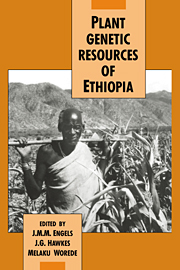Book contents
- Frontmatter
- Contents
- Contributors
- List of acronyms
- Preface
- Part I General introduction
- Part II The Ethiopian centre of diversity
- Part III Germplasm collection and conservation in Ethiopia
- 13 Theory and practice of collecting germplasm in a centre of diversity
- 14 A decade of germplasm exploration and collecting activities by the Plant Genetic Resources Centre/Ethiopia
- 15 Collection of Ethiopian forage germplasm at the International Livestock Centre for Africa
- 16 Germplasm conservation at PGRC/E
- 17 Documentation at PGRC/E
- Part IV Evaluation and utilization of Ethiopian genetic resources
- Index
13 - Theory and practice of collecting germplasm in a centre of diversity
Published online by Cambridge University Press: 30 October 2009
- Frontmatter
- Contents
- Contributors
- List of acronyms
- Preface
- Part I General introduction
- Part II The Ethiopian centre of diversity
- Part III Germplasm collection and conservation in Ethiopia
- 13 Theory and practice of collecting germplasm in a centre of diversity
- 14 A decade of germplasm exploration and collecting activities by the Plant Genetic Resources Centre/Ethiopia
- 15 Collection of Ethiopian forage germplasm at the International Livestock Centre for Africa
- 16 Germplasm conservation at PGRC/E
- 17 Documentation at PGRC/E
- Part IV Evaluation and utilization of Ethiopian genetic resources
- Index
Summary
Introduction
In the past, collecting activities have concentrated on particular species or on certain genetic characters which plant breeders were seeking. At present, because of the rapid rate of genetic erosion of crops in most parts of the world, exploration trips are now becoming ‘rescue operations’ in which as much diversity as possible is being collected. The concept of ‘now or never’ is in the forefront of the collectors’ minds.
The methodology of collecting and the scientific basis of sampling have also received considerable attention. Whereas some 30 years ago it was thought sufficient to collect a few seeds from a single plant, write one or two words on a label and put them all into a bag, this method is now thought to be most unsatisfactory.
The genetic resources collector is looking for diversity. Whereas the botanical or horticultural collector was content to collect a few herbarium specimens and a small packet of seeds, to serve as a representative for a species in a particular area, the genetic resources collector needs not uniformity, but diversity. How is this to be accomplished?
Studies of the population genetics of wild species by Allard (1970) and his colleagues showed that more sophisticated methods were needed if a reasonable amount of the genetic diversity of a species was to be captured.
- Type
- Chapter
- Information
- Plant Genetic Resources of Ethiopia , pp. 189 - 201Publisher: Cambridge University PressPrint publication year: 1991



